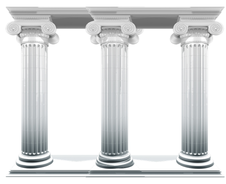What does the Bible have to say about physical healing? Jesus healed many during his earthly ministry; as did the first apostles. I have personally witnessed people receive healing from God through prayer, including myself. I know evangelists who preach the gospel to huge crowds in other countries where the Holy Spirit often heals and sets people free as a testimony to the truth of their message. Why is it that some churches teach that physical healing is available in Christ; while others insist that, since the completion of the New Testament scriptures, the gifts of the Spirit, including healing, are no longer active? Is God still healing people today, or has he backed off from the way he began the church age? In this series I will examine whether or not Jesus purchased healing for his people through his death and resurrection, whether healing is for today, why we don’t see more current examples of this gift in operation, and the difference between true faith and what I call “magical thinking”.
Sadly, we Christians sometimes dilute the Word of God to match our own experience or presuppositions. We like to make excuses.
This is called eisegesis, the process whereby we read into the Bible what we want it to say instead of pulling out its true meaning (exegesis) and conforming our thinking to that. God’s Word should set our standard for thinking, behavior, and experience, not the other way around. It may be very difficult for us to admit that we are not experiencing all that God has provided to his people, because we are afraid to think about what that says about us. It is also easy to fall prey to the influence of worldly thinking and dead church tradition.
In the short run, it may seem easier to deny that healing is for today than to struggle with why we are not experiencing it. But in the long run, we want to know what the Bible really teaches and ask the Lord to make that our experience.
Four Important Hebrew Words
Isaiah 53 is the foundation for our understanding of physical healing.
Let us begin by looking at two verses from that chapter. But first, let’s be honest in admitting we all bring to the Bible a few or maybe a lot of preconceptions and biases. This is also true for those who translate the scriptures from the original languages. Those translators who do not believe that physical healing is for today will likely reflect that belief in the words they choose to convey the meaning of the Hebrew and Greek words. Regrettably, that has been especially true of this chapter in which some key words usually are not translated according to their most natural meaning. Below I quote from the New English Translation because it is very literal and seems to have less translators’ bias than some other versions. I put the Hebrew words inside parentheses.
But he lifted (nasa) up our illnesses (choli), he carried (sabal) our pain (makob); even though we thought he was being punished, attacked by God, and afflicted for something he had done. 5 He was wounded because of our rebellious deeds, crushed because of our sins; he endured punishment that made us well; because of his wounds we have been healed. Isaiah 53:4-5 (NET1)
For us to properly understand how Jesus provided healing for us through what he suffered, we need to pay close attention to the above four highlighted Hebrew words.
- nasa – This verb means to bear or carry.
- sabal – This verb means to carry a heavy load.
- choli – This noun fundamentally means sickness.
- makob – This noun translates best as pain.
Isaiah 53:4 says that he (Jesus) lifted up or bore (nasa) our sicknesses or illnesses (choli). The same verse also says that Jesus carried (sabal) our pain (makob). The NET translates this in a most natural manner. In other words, it says it as the Hebrew says it. (You may wish to read other translations to see how they use the same words.)
Next, let’s look at how these same two Hebrew verbs are used with reference to sin. The core of the gospel hinges upon Jesus’ being a sin offering as the Lamb of God (John 1:29), which completely satisfied the wrath of God and provided forgiveness and reconciliation to those who trust in him. If he did not carry our sin on the cross, we are still lost and under God’s judgment. Isaiah 53:11-12 makes it clear that he did.
Having suffered, he will reflect on his work, he will be satisfied when he understands what he has done. “My servant will acquit many, for he carried (sabal) their sins. 12 So I will assign him a portion with the multitudes, he will divide the spoils of victory with the powerful, because he willingly submitted to death and was numbered with the rebels, when he lifted up (nasa) the sin of many and intervened on behalf of the rebels. Isaiah 53:11-12 (NET1)
Here we see above that the Hebrew verbs sabal and nasa, which are used to describe what Jesus did with our pains and sicknesses, are also used to show us what he did with our sins.
The logic is inescapable. If we are forgiven by his carrying our sins; then, we are healed by his carrying our sicknesses and pains.
If he did not carry our sicknesses and pains, he did not carry our sins. All Bible believing Christians unequivocally adhere to the latter; therefore, all should also believe in the former, whether or not we have personally experienced physical healing.
To prove that this is proper interpretation of the Hebrew, the Holy Spirit provided us with a confirmation in the gospel of Matthew.
That evening many demon-possessed people were brought to Jesus. He cast out the evil spirits with a simple command, and he healed all the sick. 17 This fulfilled the word of the Lord through the prophet Isaiah, who said, “He took our sicknesses and removed our diseases.” Matthew 8:16-17 (NLT)
The reason many find it easier to believe in forgiveness than in physical healing is because forgiveness is for us a largely subjective experience, the reality of which will be confirmed experientially when we each stand before God in judgment. At that point, we will know beyond a shadow of a doubt whether or not the gospel is true and we were completely forgiven for our sins by what Christ did for us. Healing, on the other hand, requires us to experience it in the present, which tests our faith immediately, instead of putting it off until the indefinite future. We should not back away from the trial of faith that physical healing presents. Both forgiveness and healing are part of the atonement. Both are real. Both can be our experience.
In fact, healing confirms the truth of forgiveness, according to Jesus.
Is it easier to say ‘Your sins are forgiven,’ or ‘Stand up and walk’? 6 So I will prove to you that the Son of Man has the authority on earth to forgive sins.” Then Jesus turned to the paralyzed man and said, “Stand up, pick up your mat, and go home!” 7 And the man jumped up and went home! 8 Fear swept through the crowd as they saw this happen. And they praised God for sending a man with such great authority. Matthew 9:5-8 (NLT)
Isn’t it time for us to abandon our unbelief and embrace the truth of physical healing through the atonement? Isn’t it time for our experience to rise to the level of biblical truth instead of lowering the bar to match our experience? Yes, it is.
Click here to see all the articles in this series on healing.


